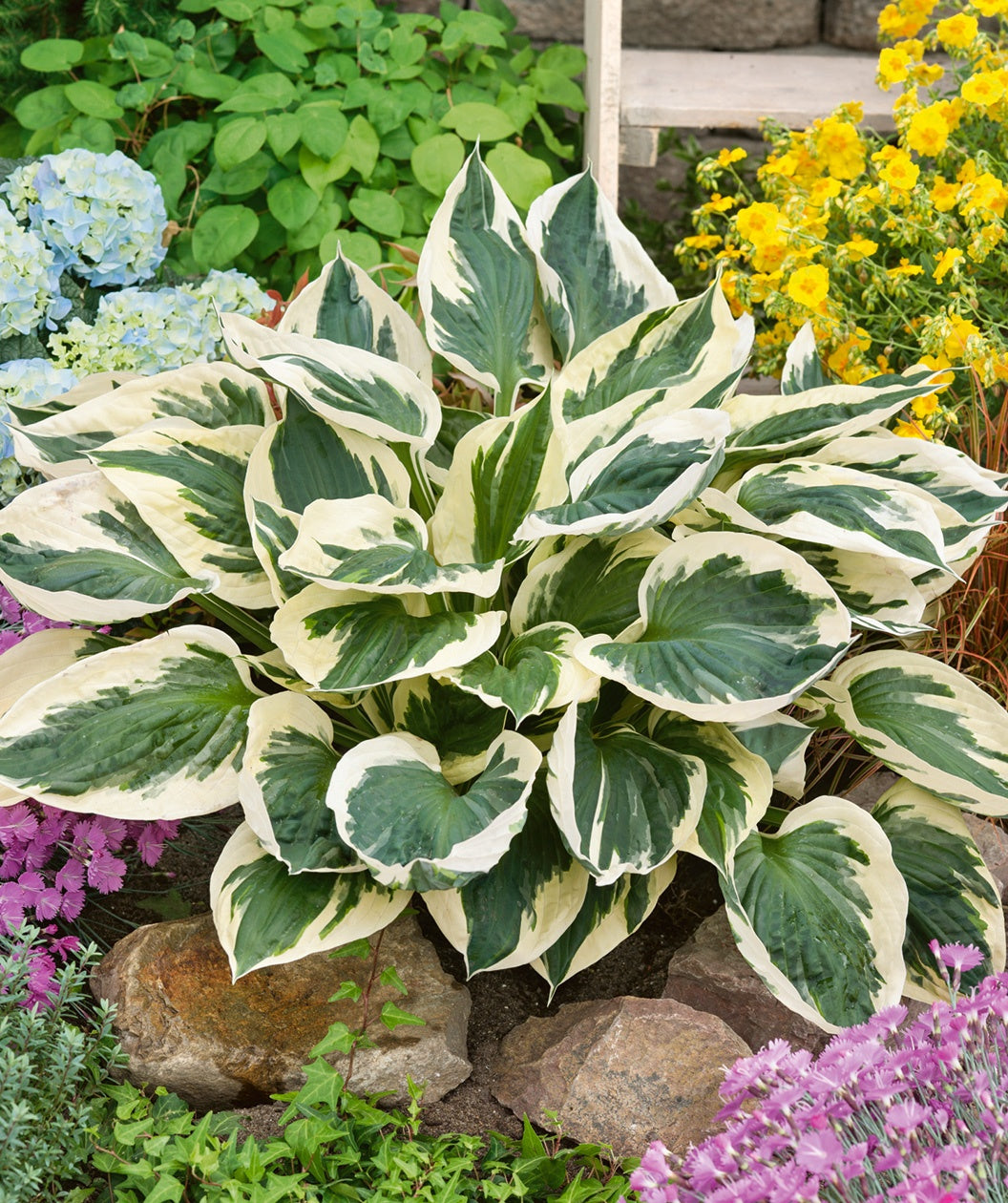


WHITE AND GREEN FOLIAGE THAT MAKES SHADY PLACES SHINE
FEATURES:
- Deep green leaves with broad, white edges emerge in spring and hold their color all season long
- In mid-summer, tall stems appear, producing light lavender blooms
- The trumpet-shaped flowers attract butterflies and hummingbirds
- Due to its thick, waxy foliage, the Patriot is largely slug-proof
- With its beautiful foliage, the Patriot will brighten the shadiest corners of your landscape but can handle a considerable amount of sun as well
- Plant the Patriot as an individual or for a more dramatic effect, in masse
- Hand Selected, Fresh from the Grower
- Ships in a plant-safe designed box
Growth Facts
- Hardiness Zone: 4-8
- Mature Height: 1-2' tall
- Mature Width: 3-4' wide
- Exposure: Part Sun/Full Shade
- Spacing: 3-4' apart
WHITE AND GREEN FOLIAGE THAT MAKES SHADY PLACES SHINE
FEATURES:
- Deep green leaves with broad, white edges emerge in spring and hold their color all season long
- In mid-summer, tall stems appear, producing light lavender blooms
- The trumpet-shaped flowers attract butterflies and hummingbirds
- Due to its thick, waxy foliage, the Patriot is largely slug-proof
- With its beautiful foliage, the Patriot will brighten the shadiest corners of your landscape but can handle a considerable amount of sun as well
- Plant the Patriot as an individual or for a more dramatic effect, in masse
- Hand Selected, Fresh from the Grower
- Ships in a plant-safe designed box
Growth Facts
- Hardiness Zone: 4-8
- Mature Height: 1-2' tall
- Mature Width: 3-4' wide
- Exposure: Part Sun/Full Shade
- Spacing: 3-4' apart
Why plant Patriot Hosta?
Make shady places shine! Patriot Hosta is one of the brightest Spirits you can buy for shady spots. This showstopper features deep green leaves bordered by a broad, gleaming white margin. It positively glows! Funnel-shaped lilac flowers adorn the leafy mounds in summer, drawing in neighborhood hummingbirds for a sip of sweet nectar. Patriot is a medium-small to mid-sized Hosta that can dazzle on its own as a specimen, though it really creates drama in masse. Consider using it as a groundcover and turn blank space into brilliant, lush foliage.
Patriot Hosta was a happy accident. Someone at Mobjack Nurseries in Foster, Virginia, accidentally sprayed a batch of Francee Hostas with a pre-emergent herbicide one day. That herbicide caused damage in the form of some wonderful new mutations! One of the FranceeHostas, normally a green-leaved plant with narrow white margins, developed very wide white margins. John Lee Machen, Jr. registered the new plant as ‘Patriot’ in 1992. In 1997, the American Hosta Growers Association bestowed upon Patriot a great honor when they named it their “Hosta of the Year.” It remains a customer favorite.
How to use Patriot Hosta in the landscape?
Hostas are simple to grow, but one challenge Hosta growers do face is slugs. Slugs love these succulent Spirits. Because Patriot Hosta has such thick, waxy foliage, however, it is largely slug-proof! They tend to shun it and go elsewhere in search of easier meals.
Planting Zones
Hardiness Zone: 4-8
How To Plant Patriot Hosta
Hostas are shade plants, and Patriot is happy there, but it is also one of the few Hostas that can handle a considerable amount of sun. With plenty of water, it can be grown in bright locations without burning, at least in the northern states. In deer-prone areas, treat with Plantskydd® to prevent grazing. Foliage will die back with the first frosts and can be cut back then. If you wish to dig and divide Patriot, you can do it at any time, but late winter/early spring is best.
How To Water
Water twice weekly for the first 3-5 weeks; then water weekly for the remainder of the year until winter. When you water, water slowly and thoroughly. Watering needs may be altered due to extreme weather conditions.
How To Fertilize
Incorporate Elements Starter Plant food granular form into the soil when planting. If planting in spring or summer start fertilizing late fall using Elements Starter Plant food granular form on an annual basis each late year. Continue this for three years to get your plant well established.
How To Prune
Each fall, just before winter sets in clean up the previous years foliage and compost it. Be sure your perennials are mulched well for winter protection. Two inches of an organic mulch will do the job. Consider leaving the plant debris in place through the winter and doing your clean up on the weather warms in the spring. While it doesn't make things neat and tidy, the debris provides overwintering protection for insects, their eggs and pupae including our native Viceroy butterfly.




